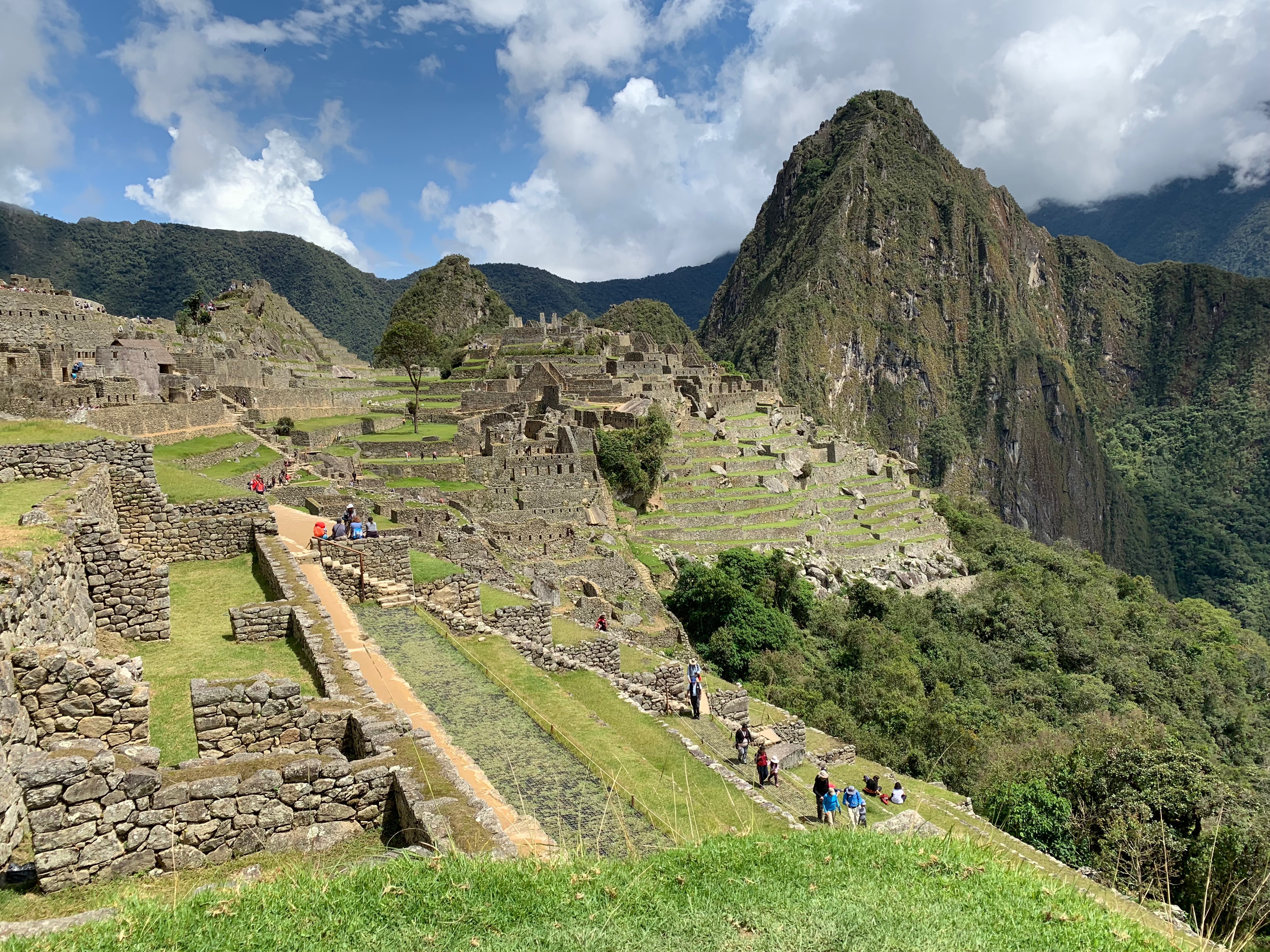
02 Nov TIO Peru: Lows & Highs, Amazonia & Machu Picchu
Susan and I arrived in Peru around midnight on October 15th, the beginning of our two-week tour of the country. After a brief introductory stay in Lima (elevation 505′) the TIO crew flew to Puerto Maldonado (elevation 600′) in the eastern lowlands. There was an intermediate stop in Cusco (elevation 11,149′) that entailed a balked landing followed by a dramatic go-around, apparently necessitated by some interesting winds on short final.
As high as it is, Cusco’s airport is surrounded by even higher ground, and for airliners looks to be a one-way runway: land one direction; take-off the opposite. This time we stayed on the plane for the 1/2 hour continuation to Puerto Maldonado, and eventually the 45-minute boat ride down the Madre de Dios River to Inkaterra Reserva Amazonica, our home for two nights in the steamy Amazon lowlands.

Motor canoes waiting at Puerto Maldonado
Both banks of the river are mostly jungle with occasional breaks with a farm or a village, apparently reached via the river. Arriving at the eco lodge, one is aware that the stairs climbing up from the Madre de Dios lead to a sanctuary that looks as though it has always been there: solid, yet airy; simple, but complete.

“Taxi Stand” at Inkaterra Reserva Amazonica
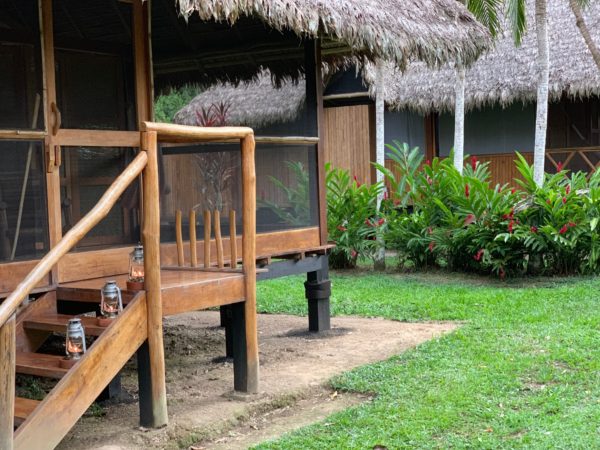
Our cabana
After we dropped our bags at our cabana, thatched roof, net sides, we attended a briefing about available excursions, then decided to rest until a night boat ride with the mission to spotlight creatures along the bank. Among the somewhat sparse wildlife we did manage to see were small caimans, one capybara, a very large rodent native to South America. There were also lots of insect sounds.

Baby caiman, night voyage
Our alarm clock the next morning was a very little, quite vociferous frog. His voice was distinct above the noisy insects that had sung us to sleep during the night. We had time to get out from under the mosquito-net tent that draped our bed inside our netted cabana, enjoy a fruit- and vegetable-loaded breakfast in the main lodge building, and meet our guide, Paolo, along with six other internationals from Cyprus and Taiwan for our first walk of the day.

Paolo with termite nest
Paolo led us down a jungle trail, with stops: to observe leaf-cutter ants hauling their loads down a tree trunk and along a path to their hill, with “quality control officials” riding with them to make sure they were not carrying disease or toxins back to their queen; disused termite nests, tree sap, vine roots, all of which have been used by indigenous people for centuries to cure various ailments. For instance, fire ants were – and are – used to cure social ills, such as marital infidelity. Ouch!

Leaf-cutter ants

Source of jungle Viagra
In addition to our nature walk, we had another destination: a hike in the sky. We soon found the tower to climb up to the jungle canopy, to the five linked suspension bridges. These were negotiated by one person at a time to control the dizzying swaying some 100′ in the air. Fine for some of us, but worrying for those with tendencies toward acrophobia or vertigo. We heard a lot of birdsong in the canopy, but otherwise it was quiet up there –with the exception of the occasional loud heartbeat or sudden intake of breath.

Jungle tower

Skywalk
Back on the ground (all eight of us made it) we continued our nature walk to the main area of the lodge, arriving in time for lunch. That break was followed by another voyage up the river, this time to the Lake Sandoval Reserve.
Lake Sandoval was once an “oxbow” on the Madre de Dios, now a stranded place of diversity in the middle of the jungle. Our party walked in via path/boardwalk, then accessed the lake by way of a many-paddled canoe. Most of the motiving power (and all of the steering) was provided by Paolo, though all of us put a paddle in the water from time to time, for whatever good it did.

Egret

Bats
Like most of the daytime along the river it was quite warm and very humid. But it was so peaceful on the lake no one complained. We didn’t see any large caimans, only one small one as we re-entered the channel leading to our put-in spot. However, there were several varieties of monkeys, including capuchin and squirrel monkeys which live symbiotically; some egrets; one tree with nocturnal bats forming an interesting pattern on its trunk; and above all, the peaceful, secluded lake.

Lake Sandoval
It was dusk by the time we got back on the 1 1/2 mile track to the boat landing. We spotlighted several tarantulas on the way home, then witnessed a beautiful evening sky above the river. Motoring back in the dark, equatorial skies full of stars, we made it back for dinner and a drink with our new-found friends.
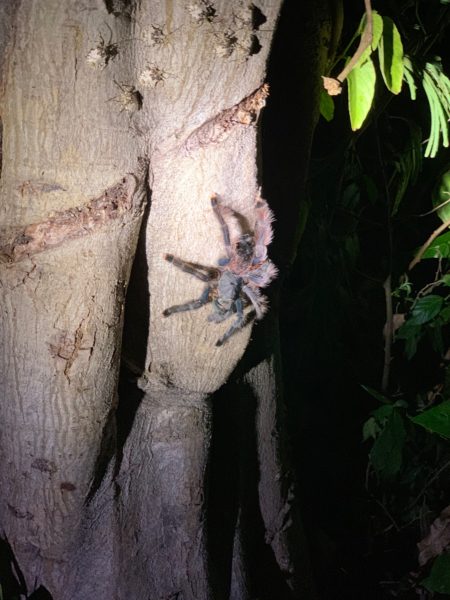
Tarantula

Evening on the river
The next day was mainly about navigating back up the Madre de Dios, thence to the airport at Puerto Maldonado for our flight to Cusco, with a short stop at a butterfly sanctuary just outside Puerto Maldonado. (About 4,000 species of butterflies make Peru their home.)

Butterfly
This time the flight into Cusco was flawless. And, as usual we were met by a guide. This time it was Mariela, who, with our driver, delivered us to our next beautiful lodging at Sol y Luna in the Sacred Valley. (See Susan’s post about our stay there.)

Sacred Valley. Note the ancient terraces.
Continuing my narrative, suffice to say we had a wonderful two-night stop at Sol y Luna and an informative (and flexible) day in the Sacred Valley.
Machu Picchu:
Sunday, October 21, we had a very early wake-up in order to meet our new guide, Nilo, at 0600. Nilo escorted us to the train at Ollantaytambo for an 0700 departure. It was a scenic ride down the Urubamba River to the starting point of the “short trail” to Machu Picchu.

Nilo, discussing the hike.
Packs on about 0830, at Chachabamba (Elevation 7380′), we’re now on the ancient Inca Trail in use for at least the last 600 years. The skies were gray, rain threatened, though it held off for most of our walk.

Crossing the Urubamba

Trailhead sign
Minutes after starting up we came to our first stop: one of the stations on the Inca Trail where the Inca messengers (chasqui), who ran this path to carry the news, met their relay runner, who would continue the communication line. It is believed this fast relay team could cover 250 miles in a day! For comparison’s sake, we ambled, stopped for lunch, photographed flowers, viewed ruins, trod cautiously on the ubiquitous stairs and covered about 8 miles in 6 1/2 hours. Guess we wouldn’t qualify to carry the Incan mail!

Relay Station
Leaving the relay station ruins, we started up a steady uphill traverse for a few hours. We were in and out of the vegetation, often seeing wildflowers, some birds, occasionally glimpsing the trail ahead or the trail we had already travelled and often the Urubamba flowing silt laden far below us on its way to and past Machu Picchu.
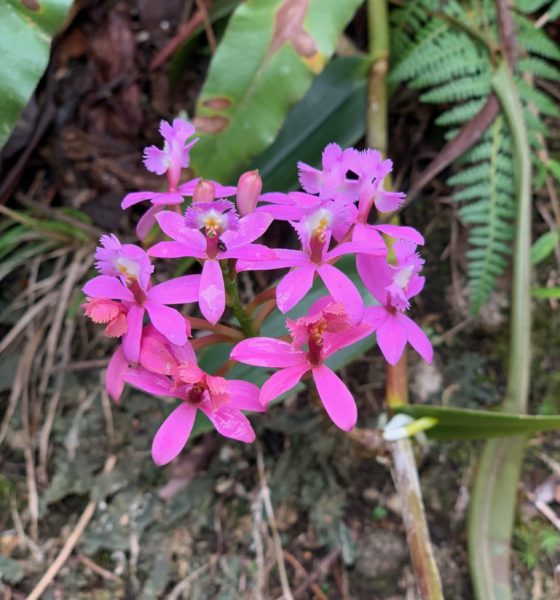
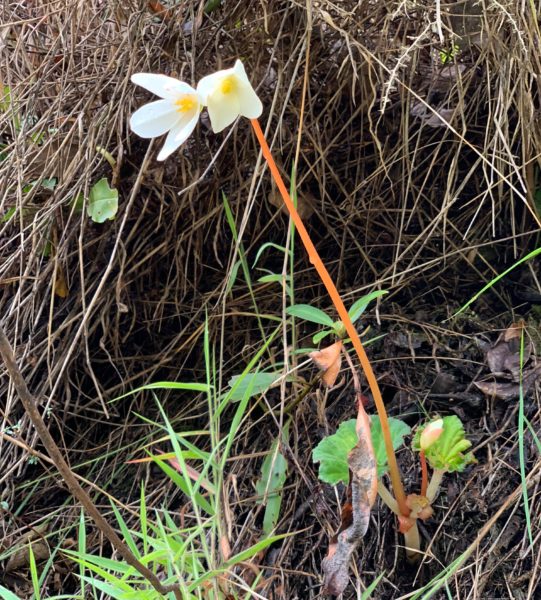
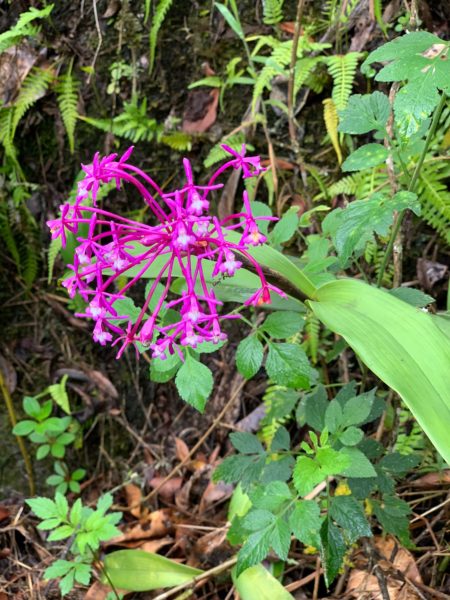

Our back trail.

Silt-laden Urubamba

Winay Wayna, an hour away.
After a long uphill traverse we got to a rest stop, after which the path goes up and down around steep flowing streams and other physical features. Many of these required steep stairs, both up and down. Eventually we reached the beautiful ruins, partially restored, of Winay Wayna. Nilo had a us stop here to explore the terraces and granaries and, of course, the view.

Stairs leading to Winay Waynu

Winay Waynu, Urubamba River below

Ruins and terraces

On top of the world
The elevation at Winay Wayne and the Sun Gate, just above Machu Picchu is the same: 8856′. One could be forgiven for thinking the few miles remaining would be a walk in the park. As a matter of fact, though I had very little actual information (e.g. no contour map), I said as much to Sus. That may explain her rather negative reaction when we encountered a lot of flights of steps, both up and down, which added at least a 1000′ to our net 1500′ altitude gain for the whole walk. And pointing out the splendid views as we rounded an exposed corner with a few thousand foot drop immediately to our right didn’t thrill her either. Did I do something wrong?
A set of 70 very steep, very narrow steps (monkey stairs, as Nilo described them) constitutes the final test to reach the Sun Gate.
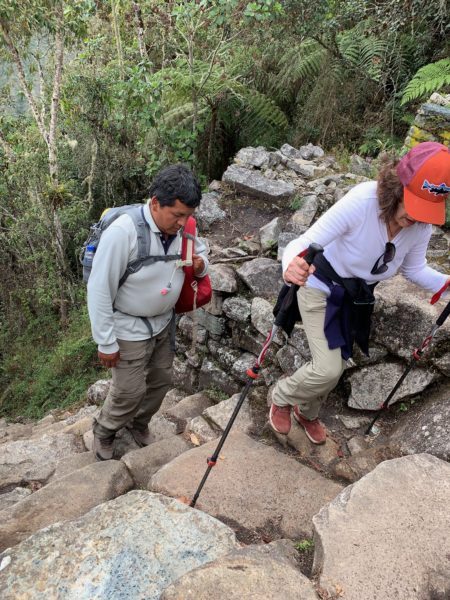
Nilo and Sus on the Monkey Steps. One step, one foot at a time.
And we all made it!
The payoff: the ever-changing views of Machu Picchu as the mists rose up out of the old city far below us. Magnificent! All the photos I had ever seen of this magical place utterly fail to adequately describe Machu Picchu. Our hike to this overlook was completely worth the effort.

First view of Machu Picchu

It disappeared, like Brigadoon.
Now what remained was to walk down to the ancient city, a mere 1000′ below us. More steps! Sus and I promised ourselves massages at the hotel in Aguas Calientes. That was another 1200′ lower, but this time on a bus. We were done with steps!

Sus, contemplating a 1000′ descent.

We’re in Machu Picchu!
Thanks, Nilo for convincing Susan she could do it. Thanks, Mariela for taking the time in Ollantaytamba on the steep steps and narrow trails in the ruins there, which helped with the terrors.
Wrap-up:
We had a river-view room at the Sumaq Machu Picchu Hotel in Aguas Calientes. The king-sized bed is adjacent to the deck that overlooks the river, and the large soaking tub is also oriented in that direction and towards the mountain beyond. In all, a very comfortable retreat following our day hike to Machu Picchu. And yes, Susan and I both received much-needed massages following our welcome drinks: Pisco Sours, of course.

Our “home” in Aguas Calientes

View from our deck
The next day we met our guide, Nilo, for a closer look at Machu Picchu. We went up to the site by bus, then walked into the main part of the historical center. We had come down through the upper section on our way in, so our emphasis was on the lower portion of the site.

In Machu Picchu
Nilo set us up near the entrance, where we had a good overall view and talked about the history, including some recent conclusions (based on a 2015 gathering of a group of anthropologists who meet annually) that the place was an educational center for the elites of Incan society and agriculture was probably one of the themes.
Machu Picchu was likely not known outside of the highest level of society, in fact its location, maybe even its very existence, was probably kept a secret. And because the Spanish annihilated the nobility living in Cusco and other areas, the ones in the know, the hidden gem remained a secret until Hiram Bingham came on the scene in 1911, following a lucky encounter with a local farmer. (When the Incas beat feet out of there in 1536, they left their ceramics, but took all the gold and silver.) In 1912, National Geographic helped clean the city. And today, 75 percent of the original site, home to about 1,000 high-ranking individuals, survives the 400 years.
During our hike with Nilo and then again the next day in Machu Picchu, we learned about the centuries devoted by the Incas to crops and their adaptation to the high elevations in this region. And about the culture’s deep understanding of astronomy. Nilo also pointed out the two houses at the edge of the ruins occupied by native families who surprised Bingham upon his arrival.
The exclusive train that we took between Aguas Calientes and Cusco, our next destination, is aptly named the Hiram Bingham. Our departure was about sunset. Given the shortness of the tropical twilight, we didn’t see much of the river and mountain views along the tracks. To compensate for the lack of scenery, there was a three-piece band that began the show with regional music, them segued into ’50s rock ‘n’ roll, going back to Bill Haley and the Comets. The bar car was rockin’! Instead of an audience, we passengers became part of the show: singing, dancing, shaking maracas and tambourines. It was a blast!

On the Hiram Bingham
Among the travelers we saw in the bar car were Chris and Ariel, a young couple from New York. When we met them again at Lake Titicaca, we struck up a conversation that resulted in meals together and a nearly instant friendship. Just another “small world” experience. Another one of the joys of travel!


Sorry, the comment form is closed at this time.